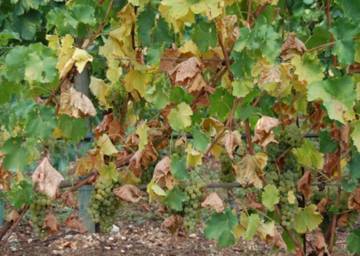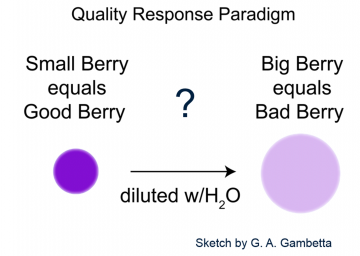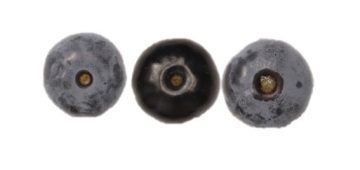Optimizing fruit composition in vineyard and orchards is crucial for enhancing fruit quality and the expansion of British Columbia (BC) fruit crops in the national and international markets.
The long-term objective of the Castellarin laboratory is to investigate the molecular and physiological mechanisms that regulate ripening and composition of grapes, blueberries, and raspberries in response to environmental factors and climates in order to develop adaptation strategies (e.g., canopy management, water-saving irrigation, variety selection, etc.) to optimize and support more sustainable grape and berry crop productions in current and future climates.
The laboratory studies how grape composition evolves in the vineyard under different environmental conditions, and how grape and wine quality can be improved through viticultural practices. This research aims to promote the development new practices to mitigate the impact of climate change and increase grape and wine quality in BC vineyards.
The Castellarin lab collaborates with the BC Berry Breeding Program supported by the BC Blueberry Council (BCBC) and the Raspberry Industry Development Council (RIDC) to select new genotypes with better local adaptation and superior fruit quality.
The major projects that the lab is currently running are:
Grapes

Impact of temperature and heat-stress mitigation strategies on grape quality in British Columbia vineyards
Heat stress events (heatwaves) are a new reality facing wine grape production. However, compared to other abiotic stresses, the negative effects of heat stress on grape production are largely unexplored. This project will analyze leaf thermal tolerance thresholds and thermal safety margins in major grapevine cultivars grown in BC, and will elucidate whether new strategies based on irrigation and bio-stimulants can mitigate heat stress and heatwaves in vineyards. In collaboration with Drs. Nathaniel Newlands and Ben Min Chang (AAFC), the Castellarin lab will conduct a regional-scale study of temperature effects on grape quality (sugars, acids, and aroma) in the Okanagan Valley (BC), and model optimal environmental conditions for grape quality (and particularly aroma) in short-term and climate change scenarios. This project is supported by the Canadian Grapevine Certification Network.
Genomic characterization of terpene biosynthetic genes in seven Vitis vinifera varieties

Each grapevine cultivar is characterized by its distinctive grape aroma, affecting the wine quality. In several cultivars, the aroma is shaped by terpenoid (mono- and sesqui-terpenoids). Their profile is controlled by terpene synthases (TPS), which are part of a largely expanded gene family. How the variation in TPS copy number and sequence among cultivars determines terpenoid profiles of grapes remains largely unexplored. This project aims to annotate TPS in the haplotypes of seven genomes (Riesling, Albariño, Fiano, Gewürztraminer, Pinot Noir, Cabernet Sauvignon, and Viognier), and to investigate TPS expression patterns and terpenoid accumulation during berry development and ripening using RNA-Seq and SPME/GC-MS platforms, respectively. This project is a collaboration with the CANTU LAB at the University of California Davis and is funded by Dr. Castellarin’s NSERC Discovery and NSERC Alliance International grants.
Impact of abiotic stresses on grape ripening and terpenoid biosynthesis

Understanding the processes that regulate grape ripening and composition/quality as well as the environmental regulation of these processes is important when developing practices to promote sustainable grape and wine production in the context of changing climates. This project aims to determine the effect of climate and, in particular, of the interaction of environmental factors such as light, temperature, and water availability, on terpenoid biosynthesis in grapes. The project investigates how light, temperature, water availability, and their interactions affect hormone levels and terpenoid biosynthesis combining controlled environment experiments with physiological measurements and genomic analyses. This project is supported by Dr. Castellarin’s NSERC Discovery Grant.
Remote sensing and variable rate fertilization: precision viticultural tools for managing intra-vineyard variability

Variations in soil properties and vine performance within vineyards impair vineyard management efficiency and grape and wine quality. This project investigates two management strategies to reduce the variation in yield and grape quality and to identify regions of the vineyards with superior grape quality. The first strategy focusses on a technique named variable rate fertilization, that allows fertilizers to be applied in variable doses within a vineyard to meet the actual needs of vines. The second strategy focuses on remote sensing-based NDVI and NDRE measurements for estimating vine vegetative growth and grape terpenoids within vineyards. We aim to study the potential of this strategy to segregate zones of different vegetative growth and terpenoid concentrations within vineyards, which would allow the production of distinct wine styles under selective harvest. This project is conducted in collaboration with Vintality Tech Inc., and is funded by MITACS and BC Investment Agriculture Foundation.
Relationships between vine isohydricity and changes of fruit growth and metabolism during water deficit

Figure taken from Gambetta et al. 2020 (Journal of Experimental Botany, Volume 71, Issue 16, 6 August 2020, Pages 4658–4676, https://doi.org/10.1093/jxb/eraa245)
The frequency of water deficits is increasing in many grape-growing regions due to climate change. Grapevine varieties differ in stomatal behavior and their ability to regulate water potential, as well as differ in changes to fruit metabolites and quality during water deficits. However, it remains unclear whether stomatal behavior and water potential regulation, often described as the degree of plant isohydricity, has any relationships with changes to fruit growth and metabolism. This project analyzed these relationships in four varieties to both short-term, severe water deficit and long-term, moderate water deficit. This project is supported by Dr. Castellarin’s NSERC Discovery Grant.
Impact of jasmonate concentrations on terpene biosynthesis in grape berries

Recent work from our lab has revealed that jasmonates (jasmonic acid, methyl jasmonate) are the hormones predominately responsible for controlling bound and free terpenoid concentrations in grape (see here). Additionally, high concentrations of jasmonates can delay berry ripening, compromising other aspects of quality. In this study, the berries of multiple wine grape cultivars were subjected to a concentration gradient of jasmonates in an in vitro berry culture system. The study also tested the impact of a synthetic hormone used commercially in crop productions as a stimulant of terpenoid biosynthesis in grapes. The goal of the project is to understand at which concentrations jasmonates are most effective at increasing terpenoid concentrations without inhibiting sugar and anthocyanin accumulation. You can find some results here. This project is supported by Dr. Castellarin’s NSERC Discovery Grant.
Light- and berry sugar-dependent nature of grape terpenoids

Aroma compounds in grapes have been shown to be strongly modulated by environmental conditions, such as light, temperature, and vine water status. Likewise, the ripeness level of berries is understood to influence aroma production. In this project, wine grapes were subjected to treatments that halt light exposure to fruit and sugar accumulation in berries mid-ripening to quantify the dependence of both factors on the development of individual terpenoid compounds. You can find some results here. This project is supported by Dr. Castellarin’s NSERC Discovery Grant.
Impact of deficit irrigation on fruit and wine aroma and quality

Our studies have shown that major metabolites that determine red wine quality (tannins and anthocyanins) are increased under water deficit conditions. Deficit irrigation strategies are often used to increase grape and wine quality in red grape varieties. Very limited information is available on the response of white grapes to water deficit. We collaborate with wineries in the Okanagan Valley (BC) to evaluate the impact of different irrigation strategies on the aromatic profile of white grapes and wines. For more information regarding this topic, click the links below:
- Transcriptome and metabolite profiling reveals that prolonged drought modulates the phenylpropanoid and terpenoid pathway in white grapes (Vitis vinifera L.)
- Regulated deficit irrigation strategies affect the terpene accumulation in Gewürztraminer (Vitis vinifera L.) grapes grown in the Okanagan Valley
- Multi-Omics and Integrated Network Analyses Reveal New Insights into the Systems Relationships between Metabolites, Structural Genes, and Transcriptional Regulators in Developing Grape Berries (Vitis vinifera L.) Exposed to Water Deficit
Identification of the molecular and hormonal signals that trigger ripening in grapes

The physiological events and the genes that trigger the ripening process remain largely unknown. This study aims to deeply characterize the molecular and physiological changes associated to the onset of ripening through large scale metabolite and gene expression (RNA-sequencing) analyses. The project has been supported by Mission Hill Estate Winery, which provided the fruit for the analyses, and Genome BC. In a medium-long term, understanding the control of ripening will help developing new vineyard practices to modulate (accelerate or decelerate) ripening in the vineyard. Click here for more information on our results.
Impact of crop size on fruit and wine aroma and quality

Adjusting the crop load in the vineyard is a very common strategy to sustain or improve fruit and wine quality. No information is available on the effect of these strategies on the grape and wine aromas. The focus of our collaborative research with the BC Wine and Grape Council is to evaluate how crop size levels in the vineyard affect the production of aromatics in white grapes. You can find some results here.
Impact of berry size on skin metabolism

Winemakers prefer smaller berries since key metabolites for wine quality are synthesised in the skin: a smaller berry has a higher skin content that results in an higher concentration of these metabolites in the wines. However, the size could directly affect the synthesis of these metabolites in the skin. We are evaluating the impact of berry size on the skin metabolism (gene expression and metabolite analyses) in order to determine how and to what extent berry size affects the compounds being synthesised in the berry. More information regarding this project can be found here.
Impact of hormone applications on berry ripening and fruit and wine aroma

Hormone application may be used as a strategy to modulate berry composition and adjust harvest date by advancing or delaying ripening. Moreover, hormone applications affect grape and wine secondary metabolites. Our collaborative research with the Wine Islands Growers Association (WIGA) aims to discover the role of plant hormones on the regulation of berry ripening and the production of aromatics in white grapes. You can find the results of this collaborations here.
Blueberries
 Assessing harvest and postharvest fruit quality in blueberries
Assessing harvest and postharvest fruit quality in blueberries
Fruit quality is considered a central trait in blueberries since it drives the consumer appreciation and purchasing interest, and provides opportunities for packers and marketers to command premium price points. Postharvest storage conditions and transit to domestic and overseas markets affects the blueberry quality and determines blueberry shelf life. Thus, improving fruit quality at harvest and postharvest is a priority for the blueberry breeders and growers of the British Columbia Blueberry Council (BCBC), our industry partner.
This project aims to tackle this priority through the analysis of fruit quality parameters in commercial and new blueberry selections at harvest and during postharvest storage. The quality parameters considered include physical (e.g., weight, size, color, texture), chemical (e.g., soluble sugars, organic acids), organoleptic (e.g., volatile organic compounds), and health-related (e.g., phenolic compounds) properties of the fruit. Optimized and validated analytical methodologies will be developed to assess the blueberry quality of new selections produced by the BCBC breeding program and compare it to the one of commercial varieties. This project is supported by the BC Blueberry Council, MITACS, and BC Investment Agriculture Foundation. You can find some results below:
- Comprehensive anthocyanin and flavonol profiling and fruit surface color of 20 blueberry genotypes during postharvest storage
- Determination of bound volatiles in blueberries, raspberries, and grapes with an optimized protocol and a validated SPME-GC/MS method
- Determination of free and bound phenolics in northern highbush blueberries by a validated HPLC/QTOF methodology
- Optimization and validation of a SPME-GC/MS method for the determination of volatile compounds, including enantiomeric analysis, in northern highbush blueberries (Vaccinium corymbosum L.)
Role of cuticular waxes on transpirational water loss in blueberries

Blueberries are becoming increasingly popular around the world in recent years, and British Columbia (BC) is one of the top producers worldwide. After being harvested, it normally takes several weeks for blueberries to enter local and international markets, during these weeks the fruit quality may decay. In fresh fruits, water loss is one of the major concerns for the preservation of fruit quality. The cuticular waxes protect fruits from water loss. This collaboration with the BC Blueberry Council aims to understand the relationship between cuticular wax composition and transpirational water loss in different blueberry varieties. You can find some results below:
- Cuticular wax biosynthesis in blueberries (Vaccinium corymbosum L.): Transcript and metabolite changes during ripening and storage affect key fruit quality traits
- Cuticular waxes affect fruit surface color in blueberries
- Blueberry water loss is related to both cuticular wax composition and stem scar size
Raspberries
 Identification of the genetic determinants of raspberry fruit quality
Identification of the genetic determinants of raspberry fruit quality
British Columbia produces over half of Canada’s raspberries, and the province’s raspberry industry is sustained by the availability of new cultivars that meet both the industry needs and consumer preferences. To maintain competitiveness, the development of cultivars with superior fruit quality is essential. The Castellarin Lab supports this effort through a genome-wide association study (GWAS) that aims to map genetic regions linked to fruit quality traits, particularly berry color. The ultimate goal of the project is to identify molecular markers to enable marker-assisted breeding of raspberry cultivars with enhanced fruit quality. In addition, the Castellarin Lab is working to optimize the collection of phenotypic data as part of the same research. A recent achievement includes the development of a high-throughput protocol for measuring raspberry puree color. This project is a collaboration between the Castellarin Lab, the Raspberry Industry Development Council (RIDC), and the Rieseberg Lab at UBC.


